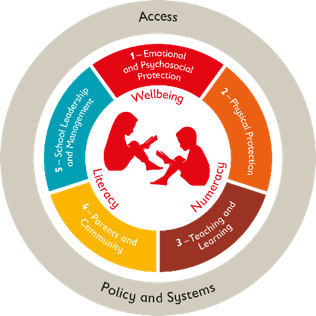
Safe Schools is a comprehensive approach to keep girls and boys safe from violence, conflict and hazards in to and from school. It contributes to our Breakthrough commitments to ensure all children learn and are protected by 2030.
The Problem
There are a number of risks facing children in to and from school that may compromise their right to education and protection.
Conflict and attacks on schools. Today, approximately 350 million boys and girls live in areas affected by conflict18. Schools are often a direct target through shelling, shooting or teargassing. Targeted killings, rape, abduction, child recruitment, intimidation, threats, political interference, military occupation, and destruction of property are just some of the ways in which education is being attacked. Between 2013 and 2017, there have been attacks on schools in at least 28 countries experiencing armed conflict and insecurity.19 In more than half of the 28 countries profiled, girls and women were specifically targeted because of their gender, both as victims of sexual violence and where armed groups opposed female education. Boys are also more likely to be targeted for recruitment into armed groups.
Violence against children by teachers, peers and other school personnel such as cleaners, guards and school management. Global studies highlight widespread violence against girls and boys in and around schools. This includes Physical and Humiliating Punishment (PHP) by teachers and school administrators, Sexual and Gender-Based Violence (SGBV) by both adults and peers, and other forms of physical and emotional peer violence. In some countries, more than 80 per cent of students suffer corporal punishment at school20 and globally, 35% of children report direct experiences of bullying in schools.21 Gender inequalities underpin much of the violence that exists. While figures of sexual harassment are often underreported, in a study conducted in the Democratic Republic of Congo (DRC), 46% of school girls confirmed being victims of sexual harassment, abuse and violence from their teachers or other school personnel22.
Hazards and disasters affect children, teachers, educational personnel and schools. Since 2000, almost 35,000 children died in schools due to 23. More than 35,000 schools have been completely destroyed, and more t24 These intense impacts are exceeded by the cumulative impacts of smaller hazards. The number one killers of school-age children are unclean water, road accidents, and drownings. Over the coming decades, 200 million children will be affected by disasters every year25.
As one student put it from grade 5
When you enter in our class, we feel soothe because our teacher become very friendly and start treating us well . Please come many times.
We are now enjoying the school environment not like in the former time where we were not aware of our rights and we used to suffer constant beatings by our teachers but now teachers are friendly and we are not afraid of them while teaching.
a P.4 student at Nyarungu Primary School said.
You can watch a video with first-hand testimony from the teacher and students in Rwanda here:
Our Approach
Safe Schools is based on the Social-Ecological Framework. This model focuses on the child in the context of their family, community and society. Interaction between these different levels and the need to work across them all in order to achieve sustainable and scalable change is highlighted throughout the approach.
Safe Schools also supports the realisation of Save the Children’s Quality Learning Framework (QLF), particularly the physical protection, psychosocial and emotional protection, and school management foundations. It recognizes that violence, conflict and hazards challenge children’s learning, and safe Schools seeks to ensure that all children can achieve their learning potential regardless of the context in which they live.

Safe Schools aims to protect children from violence, attacks and occupation, and natural and man-made hazards. It includes six components.
Impact Example: Positive Discipline in Rwanda
Our program in Rwanda identified that a priority issue for children in schools was reducing corporal punishment from teachers to students, so we implemented a program to promote positive discipline strategies. Following the program, an evaluation confirmed that students report that teachers using physical and humiliating punishment week reduced from 66% from before the project to 8% at the end of the program.
18 – Save the Children/PRIO report: “War on Children” (2018)
19 – GCPEA Education under Attack 2018
20 – http://unesdoc.unesco.org/images/0024/002466/246651E.pdf
22 – UNICEF, Plan, Save the Children and ActionAid, 2010, Too often in silence: A report on school-based violence in West and Central Africa
24 – Ibid.
25 – UNICEF (2016) Child-Centred Disaster Risk Reduction Contributing to Resilient Development. http://www.unicefinemergencies.com/downloads/eresource/docs/DRR/Unicef%20DRR%20Glossy%20Final%2018%20May%20 2016.pdf

Save the Children Canada
4141 Yonge Street, Suite 300, Toronto, ON M2P 2A8
Charitable #: 10795 8621 RR0001


Sign up for newsletters from Save the Children. You'll be the first to know how we're changing children's lives in Canada and around the world – and how your support can help us achieve remarkable results.
You'll receive updates about our work, future giving opportunities, and more.